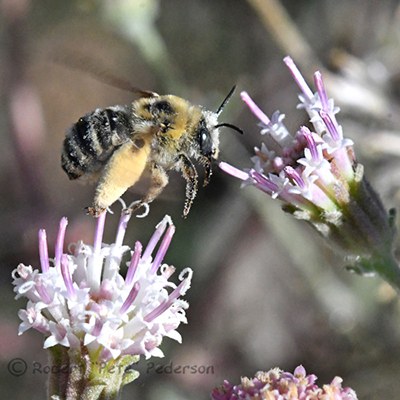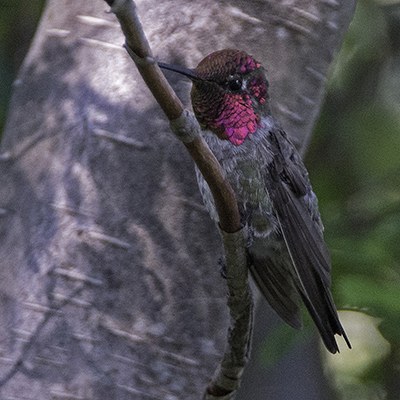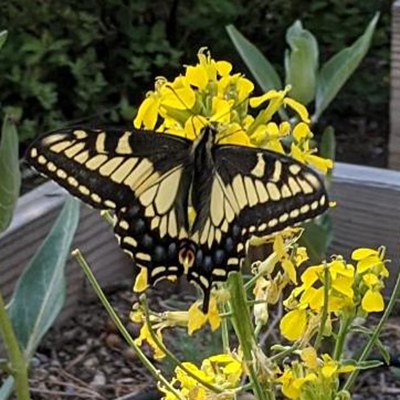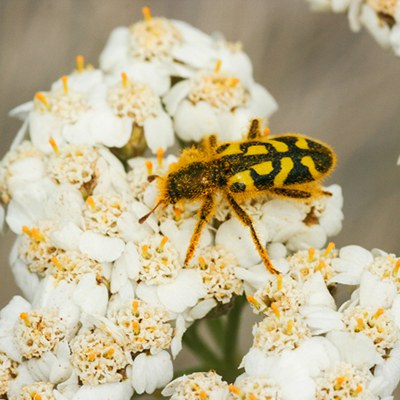The wildflowers are blooming and that means one thing—our pollinators are hard at work! It’s a busy time in the world of the buzzing, flying, and flitting.
Simply put, humans, as well as the land-based natural areas around us, wouldn’t survive without pollinators. They are essential for more than 85% of the world’s flowering plants in order to reproduce. There are also more than 150 food crops in the US that depend on pollinators; this includes almost all fruits and grains grown for human consumption.
Let’s take a peek at a few of the pollinators that call Central Oregon home.
Bees—the quintessential pollinator. But do you know how to make sure you’re looking at a bee? Here’s what distinguishes them from similar insects: long elbowed antennae (yes, that means it looks kind of like an elbow), two pairs of wings, eyes on the sides of their heads, and a place for pollen to stick, like fuzz and hairs.
Long-horned bees, which includes many species, is so named because of the unusually large antennae on the male bees. There are approximately 25 long-horned bee species that live in Oregon. They range in size from 9-15 millimeters (the size of two to three pencil-top erasers). Long-horned bees have large, brush-like hairs on their back legs that they use to carry pollen. They nest in ground tunnels. You will often spot them on flowers in the daisy/aster family, including sunflowers.
Anna’s hummingbirds are year-round residents of Central Oregon—the only hummingbird that overwinters here! They are about 4” long and weigh around 4.3 grams (about the weight of four standard-size paper clips). They have a relatively short bill for a hummingbird. They have iridescent green feathers; males have a red throat and crown, while females have a red central patch on their throat.
Hummingbirds are attracted to long, tubular flowers. They are great pollinators for penstemons, currant, and monkey flowers. When they feed on the nectar in these blooms, small bits of pollen rub off on the base of the hummingbird’s bill or on their foreheads. Both of these locations are unlikely to be groomed by the birds, leaving the pollen intact to be moved around from flower to flower as the hummingbird goes about its day feeding on nectar.
The Anise Swallowtail is a medium to large butterfly, around 3.5 inches. It has a wide variety of host plants including desert parsleys. Anise swallowtails nectar on many flowers as well, including lupine, columbine, fireweed, balsamroot, yarrow, and penstemon. Butterflies are not super efficient at moving pollen between plants, but still do help with pollination. The anise swallowtail is notable for its ability to thrive in a remarkable variety of places and conditions.
There are a few varieties of swallowtails in Central Oregon. The Anise swallowtail has wide bands of lemon- to butter-yellow on its wings, while the base of its dorsal forewings is mostly black. Of particular note are the red-orange spots with a round black pupil completely surrounded by orange on the tail of its wings. Its abdomen is black with yellow side stripes.
The ornate checkered beetle has a long, slender body with yellow and black markings that mimic a wasp to deter predators. They also have club antennae (notice the knob on the end of their antennae in the photo to the left). There are subspecies of ornate checkered beetles, including one that is mainly red and black.
These insects have an interesting life story. Females lay their eggs on flowers (a single one per flower), including on yarrow and buckwheat. When they hatch, they become parasitic to bee larvae. Once they are adults, they primarily eat pollen, but also prey on leafcutter, mason, and resin bees. Their appetite for pollen is noticeable as they are often seen covered in it!
What about bats? Are we forgetting about bats? While bats are often mentioned as pollinators (and it’s true!), all of the bats in Central Oregon are insectivorous, eating insects instead of nectar. Bats that pollinate in the United States are limited to the Southwest as it is a tropical evolutionary trait.
Now that we’ve highlighted some of the pollinators in Central Oregon, what can you do to help them? Start by taking these steps:
3 Ways You Can Help Pollinators:
- Hold the chemicals. Pesticides, herbicides, and chemical fertilizers are detrimental to pollinators. Many of these chemicals seep into the cells of plants and become very harmful to the critters that rely on the leaves, nectar, and pollen for food. So if caterpillars are munching on sprayed leaves or insects are gathering nectar or pollen, they can get sick and die.
- Variety is the spice of life. A variety of native wildflowers in your yard is great for pollinators. Grow clumps of 2-3 (or more!) plants of the same wildflower, then have 2-3 different types of wildflowers, if you have the space. If you’re short on space, you can also work with your neighbors to have a variety of plants in your neighborhood. When you're making decisions about what mix of wildflower to plant, try to pick a range of bloom times, so there's always something for the pollinators to nectar and collect pollen from spring through fall.
- Nurture pollinator nests. Many of the things we do to tidy up our yards actually translates to us removing nesting places for pollinators! Briefly, you want to leave the leaves, save the stems, and embrace bare ground. Pollinators use fallen leaves as a place to cocoon, lay their eggs, or forage for food. Meanwhile, other pollinators lay eggs inside dead stems and still others build nests by tunneling down through bare ground. Protect an important part of pollinators’ life cycle by providing these types of nesting locations.
Now that you know a little bit more about some of Central Oregon's pollinators and have some ways you can help them, join the Land Trust and our partners in making Central Oregon a great place for pollinators!
A huge thank you to Amanda Egertson, Tom Rodhouse, Basey Klopp, Michele Sims, Sue Anderson, and Pete Pederson for their help with this blog post—it truly takes a community!
Sources:
Pollinator Conservation Program, Xerces Society
Why is Pollination Important?, US Forest Service
Basic Bee ID, University of Minnesota Extension
Anna's Hummingbird, The Cornell Lab
Anna's Hummingbird (Calypte Anna), US Forest Service
Ornate Checkered Beetles Eat Bees and Pollen, University of Colorado Boulder
Learn more:


